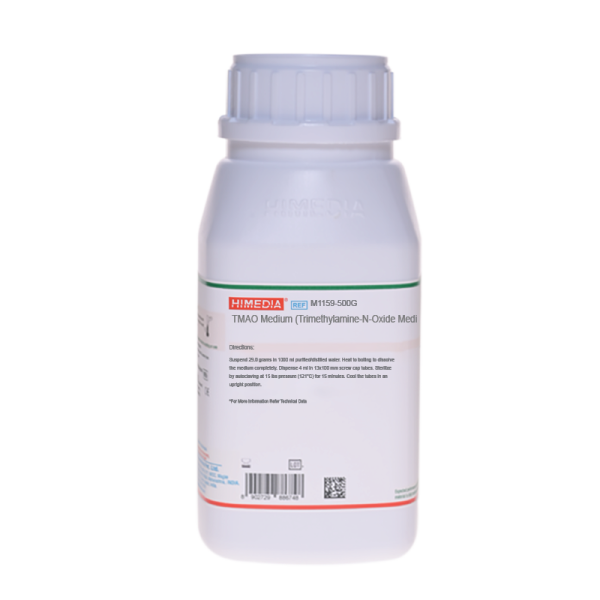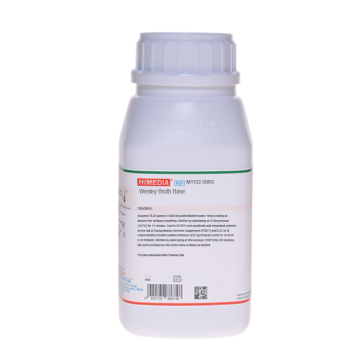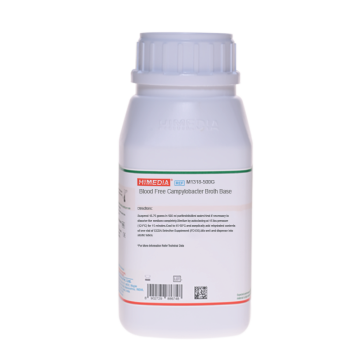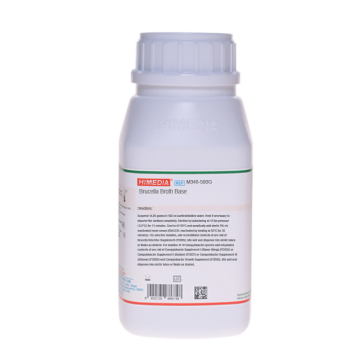 Your enquiry has been submitted
Your enquiry has been submitted
TMAO Medium (Trimethylamine-N-Oxide Medium)
Campylobacter species#CC293D
TMAO Medium (Trimethylamine-N-Oxide Medium) is used for cultivation and differentiation of Campylobacter species from foods, except Campylobacter jejuni and Campylobacter coli in accordance with APHA.
Composition**
| Ingredients | Gms/Litre |
|---|---|
| Peptic digest of animal tissue | 10.000 |
| Beef extract | 10.000 |
| Sodium chloride | 5.000 |
| Yeast extract | 1.000 |
| Trimethylamine-N-Oxide | 1.000 |
| Agar | 2.000 |
Final pH (at 25°C): 7.5±0.2
**Formula adjusted, standardized to suit performance parameters
Directions
Suspend 29 grams in 1000 ml distilled water. Heat to boiling to dissolve the medium completely. Dispense 4 ml in 13x100 mm screw cap tubes. Sterilize by autoclaving at 15 lbs pressure (121°C) for 15 minutes. Cool the tubes in an upright position.
Principle And Interpretation
Campylobacters are mainly present in the intestinal tract of animals and therefore contaminate the foods of animal origin. Campylobacter lari is a thermophilic species that was first isolated from gulls and has since been isolated from other avian species, dogs, cats and chickens. C. lari has been frequently reported from humans with bacteremia and with gastrointestinal and urinary tract infections (1). TMAO is an osmolyte found in salt water fish, sharks and rays, molluscs and crustaceans. TMAO decomposes to trimethylamine (TMA) which is the main odorant that is characteristic of degrading seafood.
TMAO (Trimethylamine-N-Oxide) Medium is prepared as recommended by APHA (2) for cultivation and differentiation of Campylobacter species from foods except Campylobacter jejuni and Campylobacter coli.
C. jejuni and C. coli are sensitive to Trimethylamine-N-Oxide and hence do not grow in this medium while growth of C. lari remains unaffected as it is not sensitive to TMAO. Therefore anaerobic growth in 1% TMAO is used to differentiate this strain from C. jejuni and C. coli.
Beef extract, peptic digest of animal tissue and yeast extract provide nitrogenous compounds, vitamin B complex and growth factors for C. lari. Sodium chloride maintains the isotonic atmosphere in the medium.
Culture is stab inoculated in upper one third of the medium and incubated in anaerobic condition for 7 days with loose caps. Growth of C. lari can be observed away from the stab line.
Quality Control
Appearance: Cream to yellow homogeneous free flowing powder
Gelling: Semisolid, comparable with 0.2% Agar gel.
Colour and Clarity of prepared medium: Yellow coloured clear to slightly opalescent gel forms in tubes as butts.
Reaction: Reaction of 2.9% w/v aqueous solution at 25°C. pH: 7.5±0.2
pH: 7.30-7.70
Cultural Response:
M1159: Cultural characteristics observed under anaerobic condition after an incubation at 42°C for 24-48 hours (further incubation upto 7 days may be required).
| Organism | Growth |
|---|---|
| Campylobacter coli ATCC 33559 | inhibited |
| Campylobacter jejuni ATCC 29428 | inhibited |
| Campylobacter lari ATCC 35221 | good-luxuriant |
Storage and Shelf Life
Store below 30°C in tightly closed container and the prepared medium at 2 - 8°C. Use before expiry date on the label.
Reference
- Murray P. R., Baron J. H., Pfaller M. A., Jorgensen J. H. and Yolken R. H., (Ed.). 2003, Manual of Clinical Microbiology, 8th Ed. American Society for Microbiology, Washington, D.C.
- Downes F. P. and Ito K., (Eds.), 2001, Compendium of Methods for the Microbiological Examination of Foods, 4th Ed., APHA, Washington, D.C.
| Product Name | TMAO Medium (Trimethylamine-N-Oxide Medium) |
|---|---|
| SKU | M1159 |
| Product Type | Regular |
| Physical Form | Powder |
| Origin | Animal |
| Packaging type | HDPE |
| References | 1. Murray P. R., Baron J. H., Pfaller M. A., Jorgensen J. H. and Yolken R. H., (Ed.). 2003, Manual of Clinical Microbiology,8th Ed. American Society for Microbiology, Washington, D.C. |
| Customized Product Available | No |









